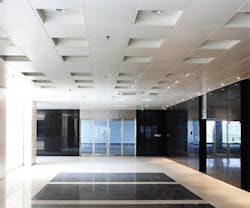While ceiling tiles often go unnoticed until they have a problem, they can add an important design element, acoustical value, and other performance perks. These ceiling components are above your head, but are not above their own potential problems.
Tile Type
The most common problem associated with ceiling tiles is not taking the space into consideration – this often leads to selecting the wrong type of ceiling tile for that space. This often happens when the decision is based on a single factor, such as price, instead of looking at the overall needs of the building.
"For example, sound control is a vital performance criterion, especially when dealing with healthcare, educational, and commercial office spaces," says Joann Davis Brayman, vice president of marketing, commercial ceilings, at Armstrong World Industries. If you take price or aesthetics into consideration, but not the acoustical needs, you are bound to make the wrong selection for your building’s needs.
However, acoustical ceiling tiles are not a blanket solution in those situations – using the same acoustical ceiling tiles throughout an entire building is not always a wise decision, as there is a significant difference in the acoustical requirements of ceilings in closed spaces and those in open spaces.
Environmental Elements
Even if you select the right ceiling tile type for your space’s needs, the tiles are still subject to the environment. "For example, most acoustical ceiling panels are designed for use in the normal occupancy temperature range and a maximum relative humidity of 70%," explains Brayman. "However, if in-service humidity and temperatures are expected to exceed these ranges (or if HVAC systems are shut off for an extended period of time), building managers should use humidity resistant panels specifically designed to withstand higher humidity levels to minimize sagging."
Not only can high humidity and temperatures lead to sagging, if present for an extended period of time, these conditions can also lead to the growth of mold and mildew. To avoid these problems, select ceiling panels that contain a broad spectrum antimicrobial treatment on the front and back, which provide resistance against the growth of mold and mildew. In addition, ceiling panels made with a fiberglass substrate are inherently resistant to microbial growth, as well as potential staining of the tile surface, which diminishes the aesthetics of the space.
Prevent the Problems
Why deal with fixing the problems associated with ceiling panels if they can be avoided altogether? By thoroughly evaluating the needs of your building during the planning stage and selecting the right panels for each space, you can ensure that the potential problems don’t occur.
"For example, if a ceiling is going to be subject to frequent plenum access, select a more impact and scratch resistant ceiling," explains Brayman. "Durable, damage resistant ceilings minimize the need for frequent replacement."
If sanitation and hygiene are key in a space, select a panel with a water-repellent, washable surface that can be easily washed with disinfecting cleaners.
In addition, improper installation and removal can result in damage and misalignments. "Tiles are mostly fragile and can be easily damaged, and worse, during maintenance and repair when they are removed and re-installed without proper professional care," says Annie Chu, principal of CHU + GOODING Architects and chair of the AIA Interior Architecture Committee. Hiring experienced, well-trained installers and training your maintenance and repair personnel are effective, low-cost ways to avoid problems with your ceiling tiles.
Select for Success
Ceiling tile selection is rarely based on just one decisive factor, like budget or acoustical performance. Other criteria, such as fire resistance, humidity resistance, light reflectance, seismic compliance, and aesthetic appeal can, and should, factor into the selection decision.
Getting to know your manufacturer’s representatives and technical resources can help you take advantage of their product knowledge and experience, ultimately helping you make the right decision about products for your space, explains Brayman. "Selection of a ceiling system then becomes a balance between design, performance, and budget."
Kylie Wroblaski ([email protected]) is associate editor of BUILDINGS.
